Natural resource management and biodiversity programs in the Hunter Local Land Services region
Updated April 2024
Hunter LLS works to deliver a variety of programs supporting NRM and native flora and fauna recovery and conservation programs at a landscape scale, to protect some of our most unique threatened species, threatened ecological communities and vegetation, important Ramsar wetlands and World Heritage Areas.
The strategic approach to our work is outlined in the Hunter Region Natural Resource Management Plan 2023-28.
We work in close partnership with a range of regional stakeholders and partner groups including (but not limited to) Hunter Region Landcare, Mid Coast to Tops Landcare, National Parks and Wildlife Service, Department of Planning, Industry and Environment- Saving Our Species teams, Mid Coast Council, Cessnock Council, BirdLife Australia, Hunter Bird Observer Groups, Hasting Birdwatchers and Hunter Wetlands Centre, Biodiversity, Conservation Trust and Local Aboriginal Land Councils.
Landholders, community groups, aboriginal groups are encouraged to seek our advice and support for biodiversity and NRM, and in addition may be eligible for funding through our incentives programs (aligned to priority programs with incentives funds).
Find out more about Hunter Local Land Services Incentive programs and our priority areas.
We deliver our program through a range of investment and funding sources, including MACH Energy Australia, Glencore Australia, Hunter Water, Australian Government (National Landcare Program), NSW Government (NRM Services), Hunter Catchments Contributions (Rates Funded).
Our programs
1. Threatened Species and Habitats Projects (National Landcare Program)
- Box Gum Woodland- Upper Hunter
- Regent Honeyeater, Swift Parrot and woodland birds- Hunter Valley
- Eastern Curlew and Shorebirds-Manning, Port Stephens and Hunter estuaries
- Australasian Bittern-Cattai and Hunter Wetlands
- Bushfire Wildlife and Habitat Recovery-Mid Coast and Greater Blue Mountains World Heritage and adjoining refugia
- Koala Bushfire and Habitat Recovery- Mid Coast and Lower Hunter
2. Weeds in Box Gum Grassy Woodlands Project (MACH Energy)
3. Natural Resource Management (NRM) Services (State Government)
4. Halls Creek Catchment Improvement Project (Glencore)
5. Paxton (Quorrobolong and Congewai Creek) Catchment Improvement Project (Hunter Water)
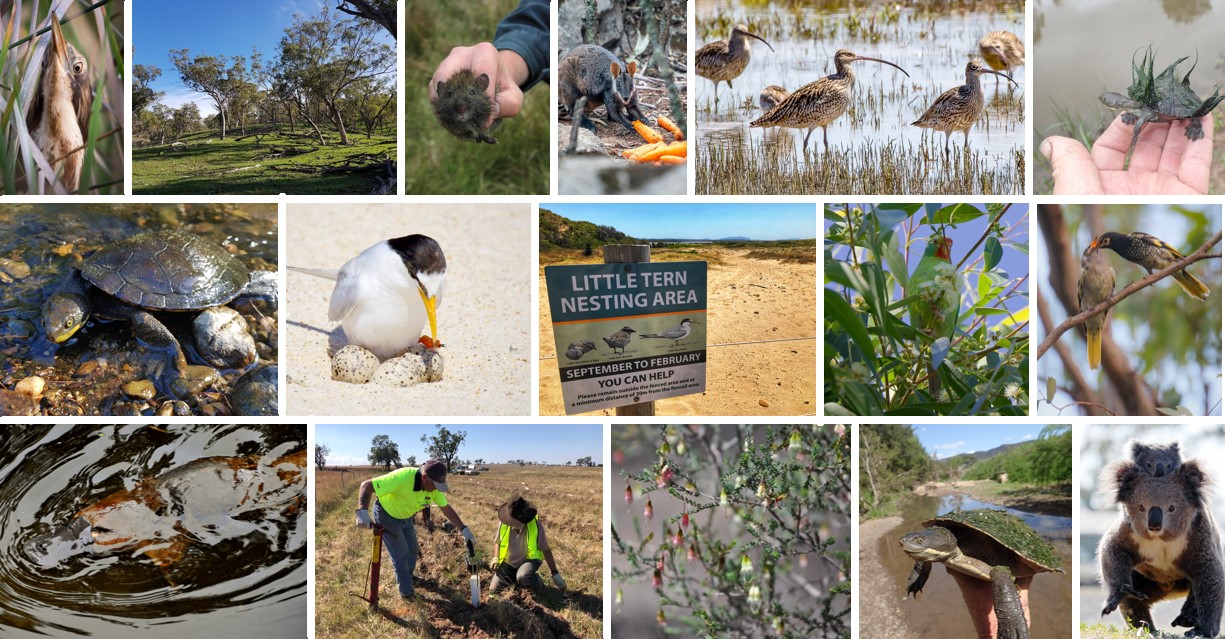
1. National Landcare Program (Phase 2) – Threatened Species and Habitats
Updated July 2021
The Australian Government National Landcare Program, aims to work in partnership with governments, industry, communities and individuals to protect and conserve Australia’s water, soil, plants, animals and ecosystems, as well as support the productive and sustainable use of these valuable resources.
The National Landcare Program (NLP) is a nationwide effort to address problems such as:
- loss of vegetation
- soil degradation
- the introduction of pest weeds and animals
- changes in water quality and flows and
- changes in fire regimes.
Regional Land Partnerships, through the NLP will focus on recovering vulnerable ecological communities, protecting threatened species, and reducing threats to our globally significant wetlands.
Additionally, the Regional Land Partnerships include sustainable agricultural projects to improve soil quality, assist farmers adapt to climate change, and respond to evolving market demands.
Information on the National Landcare Program can be found at www.nrm.gov.au
Hunter Local Land Services have been successful, and contracted to deliver projects under the program, from July 2018 until 30 June 2023.
Read the National Threatened Species Strategy Report 2021 here
NLP2 Program Contact: Lyndel Wilson, NRM Team Leader Lyndel.wilson@lls.nsw.gov.au
Hunter Local Land Services' current environment projects through the Regional Land Partnerships program include:
- Box Gum Woodland- Upper Hunter
- Regent Honeyeater, Swift Parrot and woodland birds- Hunter Valley
- Eastern Curlew and Shorebirds-Manning, Port Stephens and Hunter estuaries
- Australasian Bittern-Cattai and Hunter Wetlands
- Bushfire Wildlife and Habitat Recovery-Mid Coast and Greater Blue
- Koala Bushfire and Habitat Recovery- Mid Coast and Lower Hunter
- Woodland Birds in the Hunter
- Planting your patch
- Recognising Habitat Features of the Hunter Region
In good hands: Landcare and farmers restoring Box Gum and Grey Box Grassy Woodlands, 2018-2023
The project ‘In good hands’ will address key threats and implement recovery activities as identified in the National Recovery Plan for White Box - Yellow Box - Blakely's Red Gum Grassy Woodland and Derived Native Grassland, and pockets of Grey Box Woodlands.
The main aim for this project is to improve the condition of Box-Gum Grassy Woodland vegetation within the Upper Hunter. Farmers and Landcare members will increase their knowledge on recovery and restoration methods for Box-Gum Grassy Woodland.
Incentives will be provided to stakeholders to deliver on ground works such as fencing to manage grazing impacts of stock and weed control, to protect and improve the condition of at least 82 hectares of Box-Gum Grassy Woodland, and changed grazing practices for Box Woodland recovery in 110ha within the Upper Hunter (20km buffer of the Goulburn NP and in the Murrurundi region).
Community members will also survey for Fairy Bells (Homoranthus darwinioides) to increase the known records for this species and increase the amount of seed stored in the National Seed Bank.
This project will continue until 30 June 2023.
Project Contact: Catherine Conroy catherine.conroy@lls.nsw.gov.au
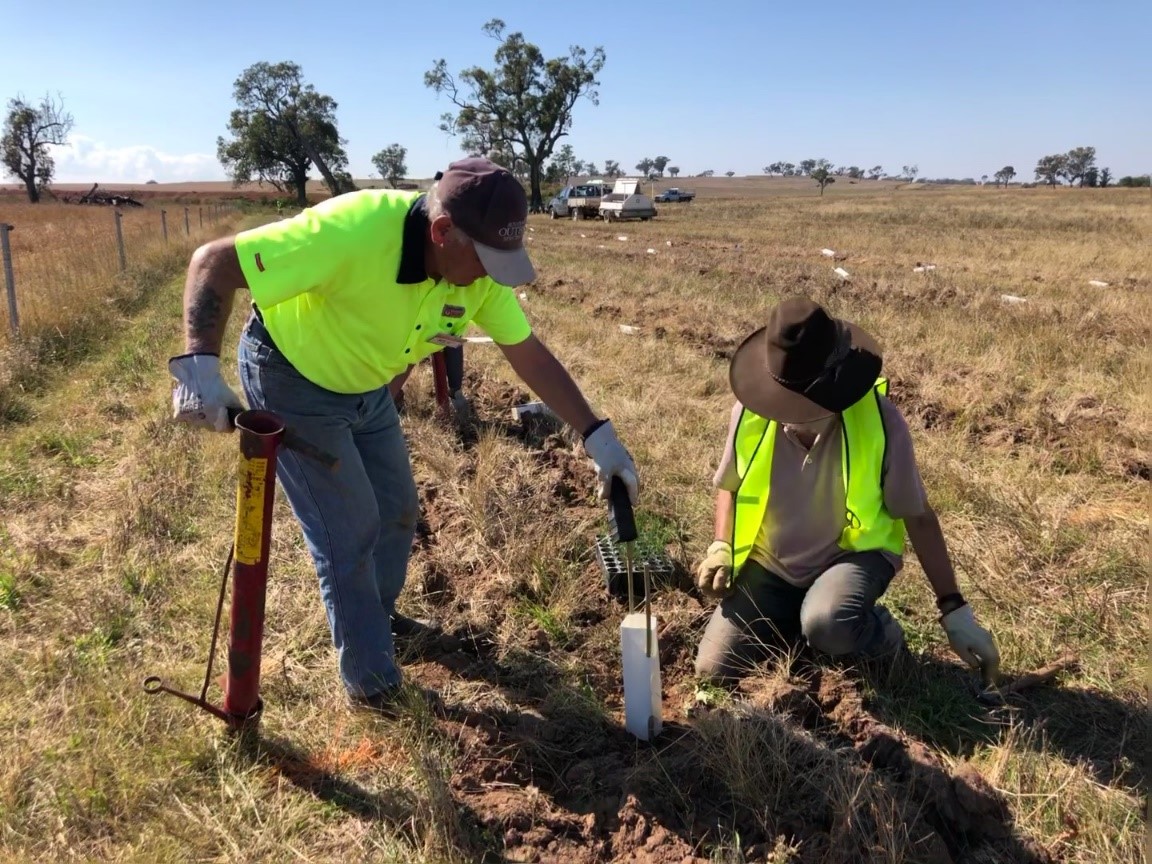
Replanting Box Woodlands as part of the Merriwa Landcare Biodiversity Inspire project, supported by National Landcare Program funding 2021
Related Fact Sheets and information:
- Fairy Bells Fact Sheet
- Merriwa Box Gum Grassy Woodland Community Survey-Full Report
- Merriwa Box Woodland –Community Survey Results Snapshot Report
- Citizen Science
- Wildlife Friendly Fencing
- Fenced but not Forgotten- managing remnant vegetation
- Ten Ways to improve the natural assets on a farm (ANU)
- Woodland Bird Conservation Action Plan- Eastern Australia (BirdLife) (external link)
- Incentives funding, submit an Expression of Interest for advice and potential funding
- Landcare in the Hunter
- A Guide to Managing Box Gum Grassy Woodlands (external link)
- Woodland Birds in the Hunter
- Planting your patch
- Recognising Habitat Features of the Hunter Region
Bringing back the Regent Honeyeater, a flagship species for our forests, farms, rivers and woodland birds: 2018-2023
We will implement recovery actions for the Regent Honeyeater (Swift Parrot & woodland birds) in priority breeding and foraging habitats of the Lower, Central and Upper Hunter, as Key National Recovery Plan actions for Regent Honeyeater are to;
- improve the extent and quality of habitat,
- increase knowledge of wild populations and,
- maintain and increase community awareness and involvement in recovery activities.
We will work with landholders, Landcare, BirdLife, DPIE, farmers, Aboriginal communities and schools through community engagement and on ground restoration through our Incentives program, and through direct engagement in priority areas.
The project will target recovery of key habitats Central Hunter Valley Eucalypt forest, White Box - Yellow Box - Blakely's Red Gum Grassy Woodland and Derived Native Grassland, and River Oak (Upper Goulburn river) through grazing and stock management and bush regeneration (weed control), revegetation, and deer monitoring (Cessnock Forests) on private property and public lands.
A schools education program in partnership with Hunter Region Landcare Network will raise community awareness, and encourage participation.
The project will also establish new formal surveys in the Upper Hunter with landcare and landholders, and maintain surveys in the Lower Hunter to monitor species movement, nesting and behaviour.
Regent Honeyeater feeding on native mistletoe, Mick Roderick (BirdLife) (Courtesy of Mindaribba Local Aboriginal Land Council) 2021
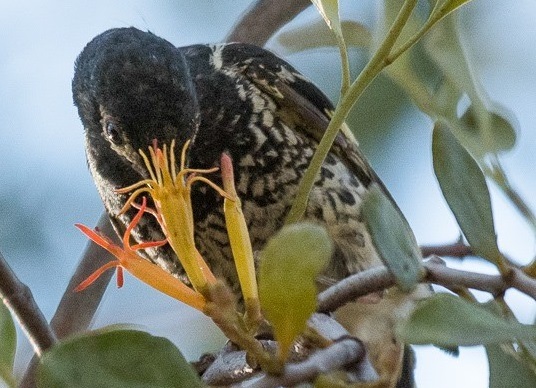
Regent Honeyeater feeding on native mistletoe, Mick Roderick (BirdLife) (Courtesy of Mindaribba Local Aboriginal Land Council) 2021
This project will continue until 30 June 2023.
Project Contact: Carolyn Jenkison Carolyn.jenkinson@lls.nsw.gov.au
Related fact sheets and information:
- Regent Honeyeater Landholder Project Fact Sheet
- Regent Honeyeater Fact Sheet
- Swift Parrot Fact Sheet
- Citizen Science
- Wildlife Friendly Fencing
- Fenced but not Forgotten- managing remnant vegetation
- Myths About Mistletoe- fact sheet
- Ten Ways to improve the natural assets on a farm (ANU)
- Woodland Birds of SE Australia (BirdLife) (external link)
- Woodland Bird Diversity in the Hunter (video)
- Birdata App-use the app to record sightings (video)
- Birdata App-woodland bird surveys (video)
- Native Mistletoe of the Hunter region (video)
- Case Study: Caring for your block for Threatened Species (video)
- Our Bushland Festival - Cessnock ourbushland.com (external link)
- Woodland Bird Conservation Action Plan- Eastern Australia (BirdLife) (external link)
- Incentives funding, submit an Expression of Interest for advice and potential funding
- Threatened Flora of the Hunter & Mid Coast - Central Hunter Valley Eucalypt Forest
- Central Hunter Valley Eucalypt Factsheet 2021
- Myths About Mistletoe workshop recording with Dr David Watson (video)
- Woodland Birds in the Hunter
- Planting your patch
- Recognising Habitat Features of the Hunter Region
Improving saltmarsh habitat and reducing threats to the Eastern Curlew 2019-2023
The project will implement recovery actions within four priority estuaries in the Hunter Local Land Services region, protecting their most unique biodiversity and species:
- Manning estuary
- internationally significant sites of Port Stephens Bay (Myall Ramsar)
- Hunter Estuary Ramsar Wetlands
- nearby Worimi Regional Park
These are identified as key habitats for Eastern Curlew (and related species) in the Hunter region.
These include critically endangered Far Eastern Curlew and EPBC Act listed migratory and resident shorebirds including the vulnerable Little Tern, and Ramsar seabird Gould’s Petrel and threatened saltmarsh habitats.
In partnership with stakeholders, Strategic Site Management Plans have been developed for 3 sites to support coordinated efforts for Eastern Curlew and EPBC Act associated species and habitats.
Key activities will include community engagement, maintaining and improving habitat, identifying and controlling invasive species, restoring the Kooragang Dykes/key roosting habitat and monitoring saltmarsh and shorebird populations. Partners will include DPIE, NPWS, Birdlife Australia, Hasting Birdwatchers, Hunter Bird Observers Club, Local Councils, Landcare groups Hunter Region Landcare and Manning Coastcare, Worimi Aboriginal Green Team, Taree Indigenous Development and Employment and landholders.
This project will continue until 30 June 2023.
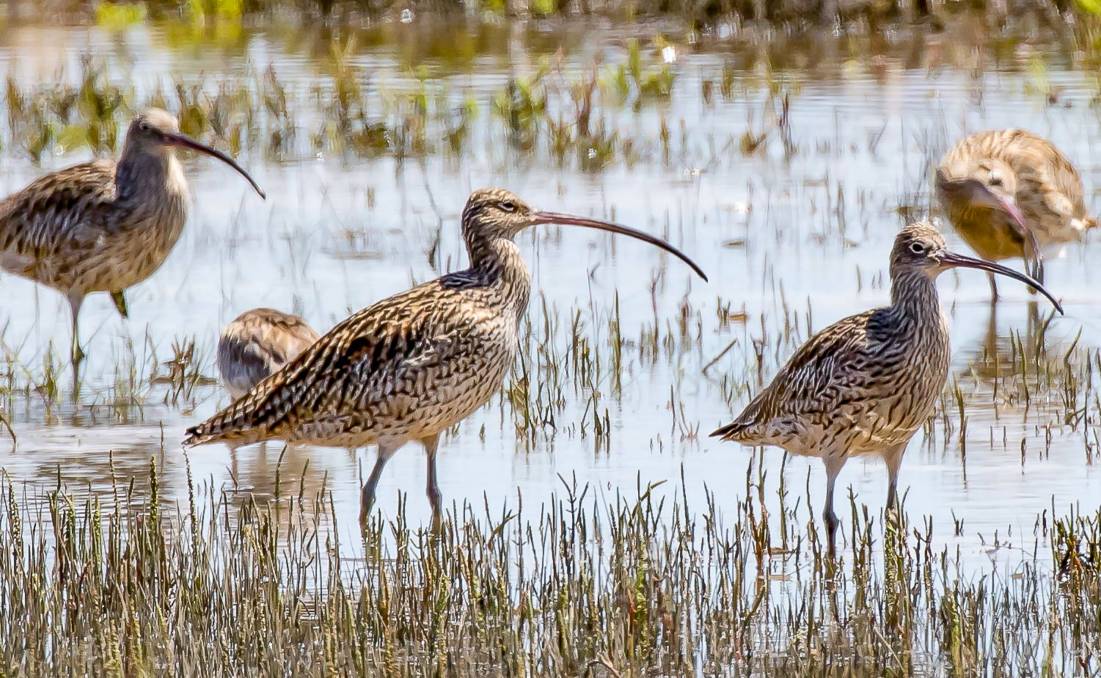
Eastern Curlew in Saltmarsh, courtesy Hunter Bird Observers Club
Project Contact: Jennifer Lewis jennifer.lewis@lls.nsw.gov.au
Related fact sheets and information:
- Eastern Curlew Fact Sheet
- Little Tern Fact Sheet
- Sharp-tailed Sandpiper Fact Sheet
- Pied Oystercatcher Fact Sheet
- Beach Stone-curlew Fact Sheet
- Saltmarsh and Shorebirds in the Hunter- (video)
- Saltmarsh and weeds in the Hunter Estuary Fact Sheet
- Shorebird News - Signage and Tracking Curlews in the Hunter(external link)
- Shorebird News - Floating Roost Trials for Shorebirds in the Hunter Estuary (external link)
- Hunter Estuary and Worimi Conservation Lands Shorebirds Action Plan
- Port Stephens Estuary Shorebirds Action Plan
- Manning Estuary Shorebirds Action Plan
- Incentives funding, submit an Expression of Interest for advice and potential funding to protect saltmarsh on your property
Understanding the Australasian Bittern to improve and protect important habitats for their survival 2019-2023
The project will improve habitat for Australasian Bittern (Bittern) in Cattai Wetlands, Myall Lakes and Hunter Estuary: Hexham Swamps, Tomago and Kooragang Wetlands and Shortland-Wallsend corridor.
The Australasian Bittern is Endangered in Australia, and specialise in living in dense beds of reeds and rushes, where they are surprisingly difficult to see, as they are particularly well camouflaged. It is hardly surprising that the species is seldom recorded. The bittern is a regular, but seldom seen, visitor to the Hunter region, including an important species to the Hunter Estuary Ramsar wetlands.
Knowledge gaps will be addressed through Bittern surveys and monitoring, overseen by BirdLife Australia, with Hunter Bird Observers and local ecologists.
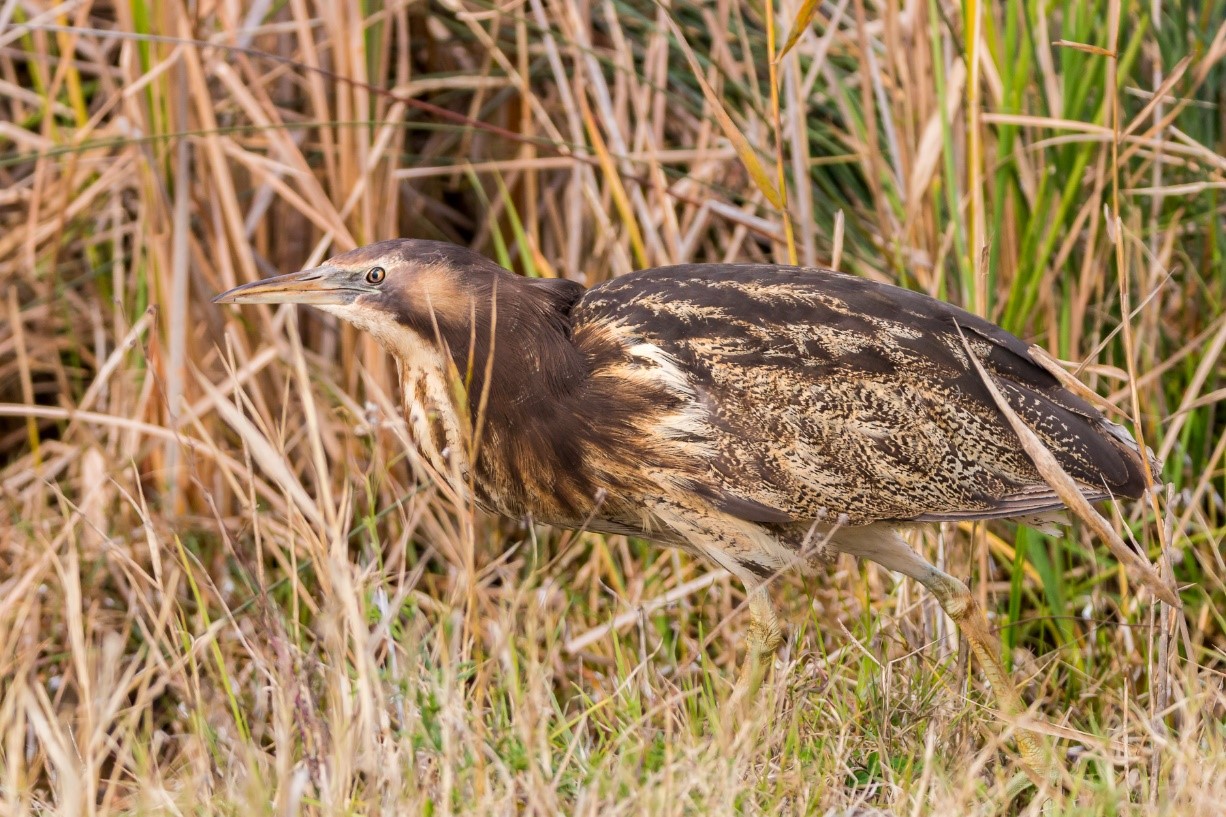
Australasian Bittern, Nathan Hays 2020
Partnerships will be formalised through a technical working group which will also confirm priorities and align existing monitoring, confirm on-ground activities and education programs and collate existing data to develop a pest animal management plan.
Planting, weed control and fencing on private and public land will improve habitat condition and extent of preferred habitats, including Rocky Knob, a significant cultural site to the Awabakal people.
Landcare groups will be engaged to build on existing habitat improvement programs. Education and engagement activities will increase awareness of the Bittern threats including fox control and recovery actions, and build landholder capacity to implement practice change, improve and connect critical habitats, with support from Hunter Wetlands Centre and Hunter Region Landcare.
Project Contact: Jennifer Lewis jennifer.lewis@lls.nsw.gov.au
Related fact sheets and information:
- Australasian Bittern Fact Sheet
- Surveying for the Australasian Bittern (video)
- Australasian Bittern- Bitterns or Bust Game (also on the Page below)
- Australasian Bitterns info and facts- Hunter Wetland Centre Bittern website
NRM Regional Bushfire Recovery in the Blue Mountains and Mid Coast Region – Hunter 2020-2022
This project will assist in the recovery and resilience of priority species, ecological communities, and natural assets in areas within and adjoining bushfire regions of the Greater Blue Mountains and Mid Coast, Gondwana Rainforests World Heritage Areas and the Mid Coast, through five sub-projects:
- Reducing predator and herbivore impacts on the recovery of threatened species and ecological communities Littoral Rainforest;
- Reducing weed impacts and supporting recovery of habitats for threatened species and threatened ecological communities Littoral and Lowland Rainforests and Coastal Swamp Oak Forest;;
- Species-specific actions or bushfire impacted fauna including Koala, Brush Tailed Rock-wallaby, Quoll, Long Nosed Potoroo, Greater and Yellow Bellied Gliders, and Regent Honeyeater;
- Protecting riparian banks for the Manning River Helmeted Turtle, Small Crayfish and Platypus
- Regent Honeyeater refuge and refugia – traditional owner led cultural and environment protecting using traditional fire practices
Efforts will be supported by the development of the Mid Coast Bushfire Threatened Species Recovery Plan and Mid Coast Koala Recovery Plan (partnered with Mid Coast Council), to assist identification of local priorities and actions within this severely bushfire impacted region, for community, agency and grass roots recovery efforts.
This project will work with partners and landholders to support a range of ongoing recovery efforts in bushfire impacted areas, including ongoing weed control, installation of protective fencing, erosion structures and enhancement of impacted vegetation through planting and weed control, nest box installation and specific species recovery actions (including pest and threat management).
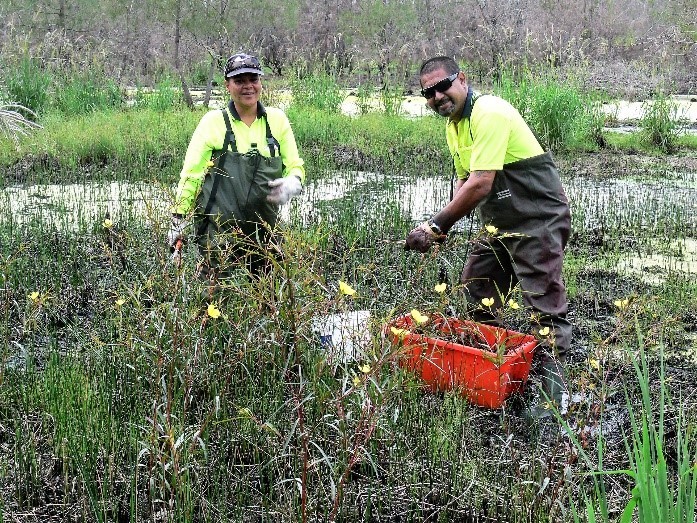
Darawank Nature Reserve - TIDE Rangers removing Ludwidgia Longifola through a National Parks and Wildlife, Mid Coast Council and Hunter LLS partnership post fire initiative 2020 (Care of NPWS)
Key partners include Mid Coast Council, Hunter Region Landcare (and landcare groups), Mid Coast to Tops Landcare and Manning River Turtle Conservation Group, BirdLife Australia, Mindaribba LALC and collaboration with National Parks and Wildlife Service and DPIE-Saving Our Species and DPI Fisheries.
Project Contact: Rye Gollan rye.gollan@lls.nsw.gov.au
Related fact sheets and information:
- Koala Fact Sheet
- Brush Tailed Rock-wallaby Fact Sheet
- Quoll Fact Sheet
- Manning River Turtle Fact Sheet.pdf
- Regent Honeyeater Fact Sheet
- Citizen Science
- Wildlife Friendly Fencing
- Fenced but not Forgotten- managing remnant vegetation
- Ten Ways to improve the natural assets on a farm (ANU)
- Incentives funding, submit an Expression of Interest for advice and potential funding for bushfire impacted (and adjoining) areas
- Planning for Koala Recovery in the Mid Coast 2021 (1 hr)
- Planning Recovery for Platypus, Manning River Turtle and instream species in the Mid Coast 2021 (1 hr)
- Helping Koalas in NSW 2021
- Saving the Manning River Turtle 2021 (Video)
- Planting your patch
- Recognising Habitat Features of the Hunter Region
Koala Recovery In the Hunter- Mid Coast and Lower Hunter Region – Hunter 2021-2022
The project will be the first regional Koala project in the Hunter for strategic Koala habitat protection and enhancement in important Koala strongholds within the Area of Regional Koala Significance (ARKS) of the Mid Coast and Lower Hunter, aligned to the NSW Koala Strategy, with three partner initiatives “Koala Safe Places”, “Paddock Regeneration for Habitat Connectivity” and “Kirrawak Post Wildfire Management Restoration” with key partners Mid Coast Council, Forestry NSW and Mid Coast to Tops Landcare Connection.
Recovery and expansion of habitat for Koala movement will be supported by Koala surveys of recovering populations, pest surveys, a regional seed collection initiative and landholder education and incentives program to support Koala habitat restoration sites on private lands within corridor and linkage areas.
Priority areas for landholder projects will be identified through the Mid Coast Koala Plan, including public and indigenous lands. Key initiatives include Koala surveys, regeneration and revegetation and protection of habitat (through fencing, weed control and fire management), and management of other threats.
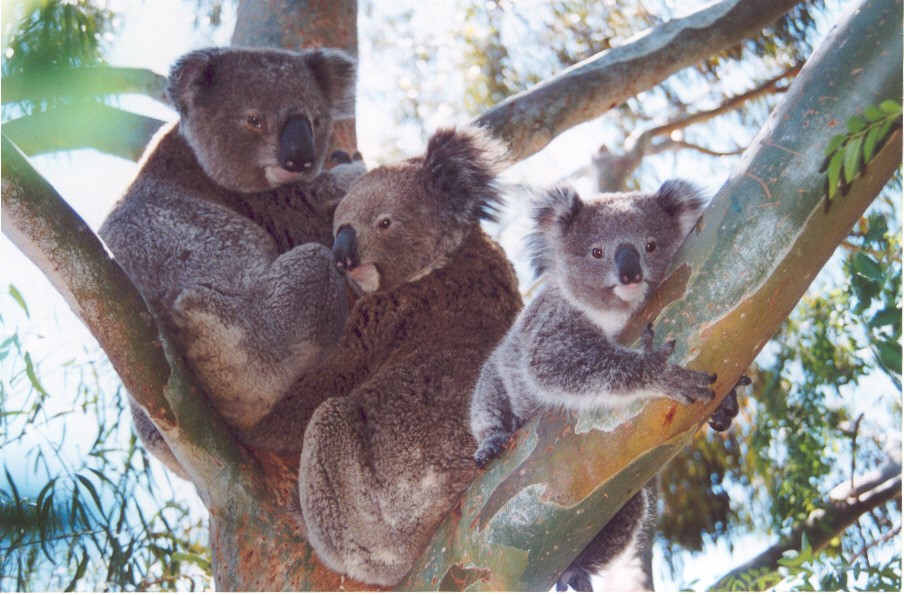
Key partners include Mid Coast Council, Mid Coast to Tops Landcare, Forestry Corporation NSW, DPIE-NSW Koala Strategy.
Project Contact: Lyndel Wilson lyndel.wilson@lls.nsw.gov.au (Lower Hunter) or Reegan Walker reegan.walker@lls.nsw.gov.au (Mid Coast)
Related fact sheets and information:
- Koala Fact Sheet (and species list)
- NSW Koala Country webpage (NSW Koala Strategy) (external link)
- Helping Koalas in NSW - Webinar
- Ten Ways to improve the natural assets on a farm (ANU)
- Creating Koala corridors (Forestry NSW) (external link)
- Citizen Science
- Wildlife Friendly Fencing
- Planting Your Patch –revegetation guide
- Fenced but not Forgotten- managing remnant vegetation
- iSpy Koala App- how to record Koala sightings (external link)
- Koala sensitive fencing - facilitating movement and protecting from threats (external link)
- Incentives funding, submit an Expression of Interest for advice and potential funding for bushfire impacted Koala habitats
- Planting your patch
- Recognising Habitat Features of the Hunter Region.
2. Weeds in Box Gum Grassy Woodlands in the Merriwa plateau (MACH ENERGY) 2019-2028
The “Weed Project - Priority Weed Management in Box-Gum Grassy Woodland (BGGW) on the Merriwa Plateau” project will deliver services to landholders in the Merriwa Plateau. The project aims to deliver high priority weed activities for up to 9 years that are consistent with the recovery actions identified in the National Recovery Plans for the White Box - Yellow Box - Blakely’s Red Gum Grassy Woodland and Derived Native Grassland Ecological Community.
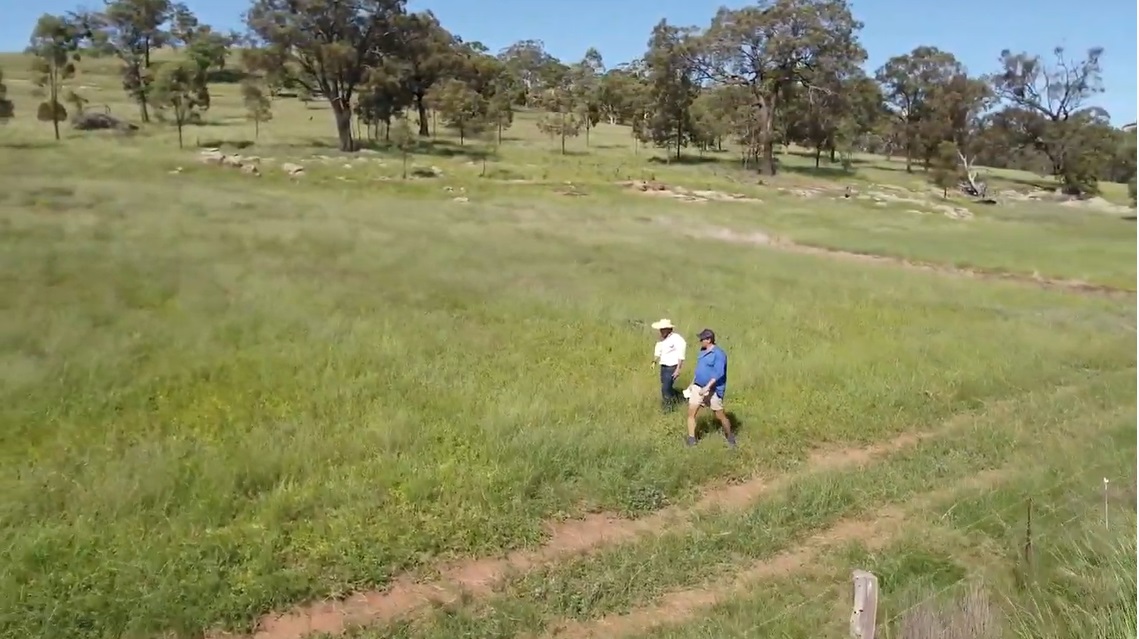
In 2018-19 we conducted a community survey with landholders in the Merriwa plateau, to understand local values, knowledge and priorities related to management of Box Gum Grassy Woodlands in the area. This survey has supported key priority initiatives through this project, and identifies priority weeds in the project area for management (priority order):
- Prickly Pear
- St Johns Wort
- Blue Heliotrope
- Fireweed
- Noogoora Burr
- Boxthorn
- Blackberry and Bathurst Burr
Merriwa Box Woodland –Community Survey Results Snapshot Report
In 20/21 we engaged with Upper Hunter Weeds Authority and DPI NSW to develop local Blue Heliotrope trials, develop a Blue Heliotrope Manual, and support additional biological research studies relevant to NSW management of this weed in woodland settings. Landholders and specialists will be invited to participate in the BH Best Practice Management Guide to contribute to local case studies and local methods of control.
Activities to be delivered, through this project, include:
- Research programs and trials- including Blue Heliotrope
- Landholder engagement-extension advice, planning and support
- Education and awareness activities
- Weed and grazing plans
- Incentive programs - on ground activities with landholders
Hunter Local Land Services invites land managers within the Merriwa plateau to submit an expression of interest to undertake weed control and/or revegetation within remnant Box-Gum Grassy Woodland using this form. Further details, including project and landholder eligibility, can be found within the form.
This project is supported through funding from MACH Energy Australia.
Project contact: Catherine Conroy Catherine.conroy@lls.nsw.gov.au
Related information:
- Merriwa Box Gum Grassy Woodland Community Survey - Full Report
- Merriwa Box Woodland - Community Survey Results Snapshot Report
- Blue Heliotrope - Plan of Attack Video
- Citizen Science
- Wildlife Friendly Fencing
- Planting Your Patch - revegetation guide
- Fenced but not Forgotten - managing remnant vegetation
- Ten Ways to improve the natural assets on a farm (ANU)
- Woodland Bird Conservation Action Plan - Eastern Australia (BirdLife) (external link)
- Incentives funding, submit an Expression of Interest for advice and potential funding
- Landcare in the Hunter
- A Guide to Managing Box Gum Grassy Woodlands (external link)
3. NRM Services Programs and Support 2021-2023
Can you Dig It? A new program to support small-scale revegetation projects.
Hunter Local Land Services piloted a new program in 2021 to support landholders in the Hunter region to implement small native revegetation projects: Dig It- Small-scale Revegetation. With current suitable weather conditions, and more awareness on the value of native vegetation, ecosystem services, natural capital and improved productivity benefits on farm, we have developed this program.
Through the pilot program, we supported 17 individual native revegetation projects, ranging from wildlife corridors, shelterbelts, dam enhancement plantings and riparian revegetation.
We will support landholders to:
- Extend existing remnant vegetation areas
- Improve structural diversity of existing remnant vegetation
- Create new shelterbelts or habitat corridors that link reserves or patches
- Connect or incorporate existing mature paddock trees
- Protect and enhance farm dams or riverbanks.
To do this, we will provide more training across the region in seed collection and home-propagation, revegetation methods and tips, landholder advice, planning and support, and other guidelines and resources including a small grants program.
UPCOMING COURSES AND WORKSHOPS
- Seed Collection and Propagation September 2022 (Millfield, Kooragang) and February-March 2023 (Cessnock, Kooragang, Taree)
- Revegetation Basics- October 2022 (Dungog, Singtleton, Taree).
– see our Events Page, Facebook page or register an EOI below to receive invitations to upcoming workshop dates. We will also work with Landcare Networks and other partners to extend their current support to landcare group and members to also “grow” their revegetation projects in the region.
How to get involved?
Get in touch with Hunter Local Land Services by submitting an Expression of Interest (EOI) through the link below. We have many other strategic programs and priority funding available (check our priority map), and by submitting an EOI we will assign you to the appropriate Local Land Services advisory officer, who will tailor their support and advice based on your needs, interests and options. Our small grants program will invite landholders who have sought EOIs to apply to funding where they align to the program.
Hunter LLS Expression of Interest Form.
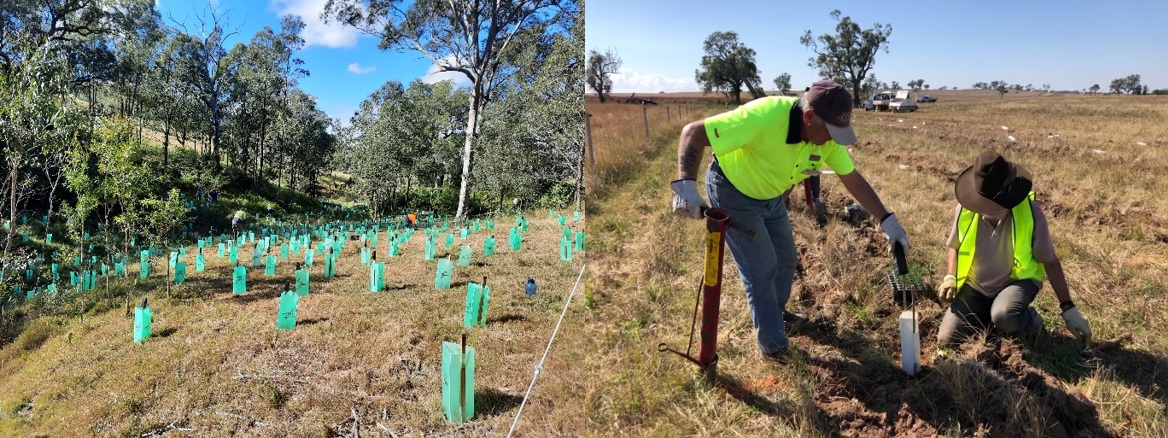
Relevant Resources:
- Planting Your patch
- Recognising Habitat Features of the Hunter Region
- Reveg ready! Revegetation for Woodland Birds Webinar- 2021 (Video)=
- DPE: Trees Near Me App- species lists and vegetation types on your property
- Wildlife Friendly Fencing Apr 2021 PDF, 1595.87 KB
- Breaking down myths about mistletoe Nov 2020 PDF, 963.96 KB
4. Halls Creek Catchment Health Improvement Project 2019-2023
Hunter Local Land Services and Glencore Australia are working with Landholders in the Upper Hunter to improve the health of Halls Creek and its catchment, and building on work with Glencore in previous ye in the adjoining Wybong Catchment.
Landholders in these catchments have been supported to improve the health of native vegetation and reduce soil erosion on river-banks, manage stock and reduce sediment or runoff entering the catchment, and enhance pockets of vegetation for native wildlife.
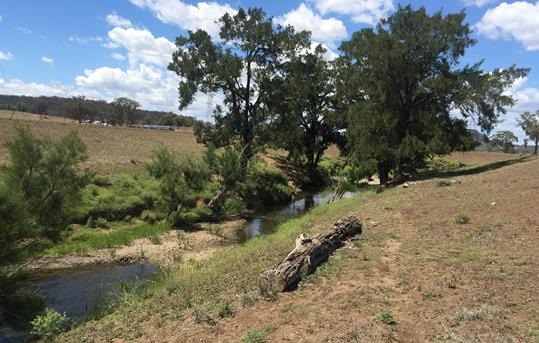
The project has supported multiple projects with:
- Riparian restoration and creek bank vegetation protection through fencing and stock watering
- Grazing and fertiliser management through holistic management and grazing systems
- Enhancement of native vegetation through weed control and revegetation
- Monitoring of woodland birds, as indicators for catchment health
Hunter LLS invite land managers in the Halls Creek and Giants Creek catchments to submit an expression of interest to undertake on-ground riparian (stream/riverbank) enhancement works using this form. Further details, including project and landholder eligibility, can be found within the form.
Contact: Catherine Conroy, Catherine.conroy@lls.nsw.gov.au
Project Related Information:
- Stock and Waterways Guide (NSW) includes the following topics:
- Riparian Land
- Cost of Poor Riparian Management
- Managing Stock and Waterways
- Planning for Success
- Riparian Fencing
- Watering systems
- Crossings
- Responsible Grazing
- Ongoing Riparian Care
- Riparian Health Check
- Case Study: Halls Creek Catchment Improvement Video
- Wybong Woodland Bird Monitoring Results 2021
- Halls Creek Woodland Bird Monitoring Results 2021
- Ten Ways to improve the natural assets on a farm (ANU)
- Hunter LLS Soil Moisture Probes - Monitoring Network
- Wildlife Friendly Fencing
- Planting Your Patch - revegetation guide
- Fenced but not Forgotten - managing remnant vegetation
- Regent Honeyeater Landholder Project Fact Sheet
- Regent Honeyeater Fact Sheet
- Swift Parrot Fact Sheet
- Halls Creek News - Blue Heliotrope Management - Col Bates 2020
5. Paxton (Quorrobolong and Congewai) Catchment Improvement Project 2019-2023
For the past five years, Hunter Water and Hunter Local Land Services have worked together to provide small grants and advice to landowners to complete creek protection works on their properties to protect and enhance creek banks and adjoining lands. This work has been complemented by the Hunter Catchments Contributions erosion and stream bank stabilisation works in several locations within the Catchment, supported by Hunter LLS staff and LLS Soil Conservation Service.
The aim of this work was to improve the water quality in Congewai and Quorrobolong Catchments. These Catchments include Cony, Congewai, Sandy, Clink, Reedy, Stewarts, John Elm, Wallaby Gully and Quorrobolong creeks and their tributaries.
Hunter Water has invested more than $400,000 in the project, with landholders contributing over $500,000 in in kind and funding towards on ground project work to protect creeks and improve water quality. The project was managed by Hunter LLS.
Altogether, the partnership has rehabilitated 43 hectares of riparian land (land along the banks of creeks) and protected 18 kilometres of creek bank through stock exclusion fencing, troughs and erosion control. The project has also improved grazing practices across 180 hectares of adjoining grazing lands, increasing pasture cover and reducing sediment and nutrient runoff into the creek.
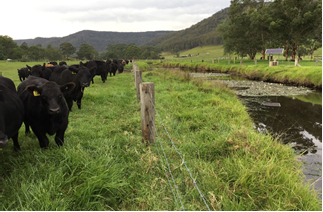
Riverbank fencing and stock watering on Congewai Creek.
In 2021 the project will wrap up, including conducting assessment of the on-ground benefits for water quality and riparian rehabilitation and protection, community survey on how the project has benefited the catchment region, and identify future actions that may be delivered in the region for similar benefits.
Partner investors: Hunter Water and co-contributions from the Hunter Catchments Contributions
Project Contact: Carolyn Jenkinson Carolyn.jenkinson@lls.nsw.gov.au
Related fact sheets and information:
- Rural Living Handbook
- Stock and Waterways Guide (NSW) includes the following topics:
- Riparian Land
- Cost of Poor Riparian Management
- Managing Stock and Waterways
- Planning for Success
- Riparian Fencing
- Watering systems
- Crossings
- Responsible Grazing
- Ongoing Riparian Care
- Riparian Health Check
- Ten Ways to improve the natural assets on a farm (ANU)
- Wildlife Friendly Fencing
- Planting Your Patch –revegetation guide
- Fenced but not Forgotten - managing remnant vegetation
- Regent Honeyeater Landholder Project Fact Sheet
- Regent Honeyeater Fact Sheet
- Swift Parrot Fact Sheet
Updated August 2021